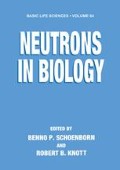Abstract
The familiar extremes of crystalline material are single-crystals and random powders. In between these two extremes are polycrystalline aggregates, not randomly arranged but possessing some preferred orientation and this is the form taken by constructional materials, be they steel girders or the bones of a human or animal skeleton. The details of the preferred orientation determine the ability of the material to withstand stress in any direction. In the case of bone the crucial factor is the orientation of the c-axes of the mineral content — the crystals of the hexagonal hydroxyapatite — and this can readily be determined by neutron diffraction. In particular it can be measured over the volume of a piece of bone, utilising distances ranging from 1mm to 10mm. The major practical problem is to avoid the intense incoherent scattering from the hydrogen in the accompanying collagen; this can best be achieved by heat-treatment and it is demonstrated that this does not affect the underlying apatite. These studies of bone give leading anatomical information on the life and activities of humans and animals — including, for example, the life history of the human femur, the locomotion of sheep, the fracture of the legs of racehorses and the life-styles of Neolithic tribes. We conclude that the material is placed economically in the bone to withstand the expected stresses of life and the environment.
The experimental results are presented in terms of the magnitude of the 0002 apatite reflection. It so happens that for a random powder the 0002, 1121 reflections, which are neighbouring lines in the powder pattern, are approximately equal in intensity. The latter reflection, being of manifold multiplicity, is scarcely affected by preferred orientation so that the numerical value of the 0002/1121 ratio serves quite accurately as a quantitative measure of the degree of orientation of the c-axes in any chosen direction for a sample of bone.
Access this chapter
Tax calculation will be finalised at checkout
Purchases are for personal use only
Preview
Unable to display preview. Download preview PDF.
References
Bacon, G. E., (1990). The dependence of human bone texture on life style. Proc. R. Soc. Lond., B240:363–370.
Bacon, G. E., & Goodship, A. E., (1991). The orientation of the mineral crystals in the radius and tibia of the sheep, and its variation with age. J. Anat., 179:15–22.
Bacon, G. E., & Griffiths, R. K., (1985). Texture, stress and age in the human femur. J. Anat., 143:97–101.
Bacon, G. E., Bacon, P. J., & Griffiths, R. K., (1977). The study of the bones by neutron diffraction. J. Appl. Cryst., 10:124–126.
Bacon, G. E., Bacon, P. J., & Griffiths, R. K., (1979a). Stress distribution in the scapula studied by neutron diffraction. Proc. R. Soc. Lond., B204:355–362.
Bacon, G. E., Bacon, P. J., & Griffiths, R. K., (1979b). The orientation of apatite crystals in bone. J. Appl. Cryst., 12:99–103.
Bacon, G. E., Bacon, P. J., & Griffiths, R. K., (1984). A neutron diffraction study of bones of the foot. J. Anat., 139:265–273.
Kitchener, A. C., Bacon, G. E., & Vincent, J. F. V., (1994). The Irish elk used its antlers for fighting. Biomimetics, 2:297–307.
Wolff, J., (1870). Die innere Architecktur der Knocken. Virchows Archiv fur pathologische Anatomie und Physiologie, 50:389–345.
Wolff, J., (1899). Die Lehre von der functionellen Knockengestallt. Virchows Archiv fur pathologische Anatomie und Physiologie, 155:256.
Author information
Authors and Affiliations
Editor information
Editors and Affiliations
Rights and permissions
Copyright information
© 1996 Springer Science+Business Media New York
About this chapter
Cite this chapter
Bacon, G.E. (1996). Neutron Anatomy. In: Schoenborn, B.P., Knott, R.B. (eds) Neutrons in Biology. Basic Life Sciences, vol 64. Springer, Boston, MA. https://doi.org/10.1007/978-1-4615-5847-7_2
Download citation
DOI: https://doi.org/10.1007/978-1-4615-5847-7_2
Publisher Name: Springer, Boston, MA
Print ISBN: 978-1-4613-7680-4
Online ISBN: 978-1-4615-5847-7
eBook Packages: Springer Book Archive

